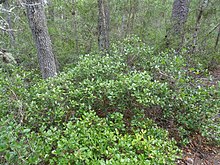| Myrtle oak | |
|---|---|

| |
| Leaves and acorns of myrtle oak | |
| Scientific classification | |
| Kingdom: | Plantae |
| Clade: | Tracheophytes |
| Clade: | Angiosperms |
| Clade: | Eudicots |
| Clade: | Rosids |
| Order: | Fagales |
| Family: | Fagaceae |
| Genus: | Quercus |
| Subgenus: | Quercus subg. Quercus |
| Section: | Quercus sect. Lobatae |
| Species: | Q. myrtifolia
|
| Binomial name | |
| Quercus myrtifolia | |

| |
| Synonyms[2] | |
|
List
| |
Quercus myrtifolia, the myrtle oak,[3] is a North American species of oak. It is native to the southeastern United States (Mississippi, Alabama, Florida, Georgia, South Carolina). It is often found in coastal areas on sandy soils.[4]
It is an evergreen tree that can reach 12 meters (39 feet) tall, also appearing as a shrub in drier sites. It has leaves with no teeth or lobes, which are hairless on the upperside and also on the underside except along the veins.[5]

- ^ Wenzell, K.; Kenny, L. (2015). "Quercus myrtifolia". IUCN Red List of Threatened Species. 2015: e.T194204A2303967. doi:10.2305/IUCN.UK.2015-4.RLTS.T194204A2303967.en. Retrieved November 12, 2021.
- ^ "Quercus myrtifolia Willd. — The Plant List". theplantlist.org. Retrieved August 28, 2015.
- ^ USDA, NRCS (n.d.). "Quercus myrtifolia". The PLANTS Database (plants.usda.gov). Greensboro, North Carolina: National Plant Data Team. Retrieved September 15, 2015.
- ^ "Biota of North America Program 2014 county distribution map". bonap.net. Retrieved August 28, 2015.
- ^ "Flora of North America, Quercus myrtifolia Willdenow, 1805. Myrtle oak". efloras.org. Retrieved August 28, 2015.
